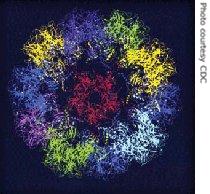2007年VOA标准英语-Study: Common Sexually-Transmitted Virus Found(在线收听)
By David McAlary
Washington
28 February 2007
watch Barry Unger HPV report
A sexually-transmitted virus that is a leading cause of female cancer deaths in developing countries is also very prevalent in the United States. It is the human papillomavirus, or HPV, which can cause cervical cancer. As VOA's David McAlary reports, a new government study shows that one in four American women have it.
 |
| Virus-like particles (VLPs) assembled from the L1 protein of Human Papillomavirus 16 |
Eighty percent of HPV cases occur in developing countries, but research from the U.S. government's Centers for Disease Control reveals that American women are also highly susceptible.
"More women have HPV infection than we previously thought," said Centers for Disease Control physician Eileen Dunne. She estimated U.S. human papillomavirus rates by using health data from more than 2,000 women ages 14 to 59.
"We found that overall HPV prevalence among females in the United States 14 to 59 years of age was 26.8 percent. That means one in four women are infected with HPV. The prevalence was highest among the 20 to 24-year-old women. Almost half of those women were infected with HPV," she explained.
The findings are published in the Journal of the American Medical Association.
Dunne says the number of HPV-infected women is probably higher than the study shows because it measured only active infections.
Dr. Ira Horowitz of the Emory University School of Medicine in Atlanta is not surprised. He sees many patients with HPV infections.
"I see teenagers who have had intercourse with just one partner all the way to women in their eighties who have been exposed to the virus and now have manifestations as abnormal pap smears and pre-cancerous lesions," said Horowitz.
There are hundreds of kinds of HPV infections that do not cause cervical cancer. Dr. Dunne at the Centers for Disease Control says most women clear them, but some types remain to lead to the cancer.
"3.4 percent of women had infection with the types of HPV that could be prevented by the HPV vaccine," said Dunne.
A new vaccine covers the two HPV types that cause most cancer and two types that cause genital warts. An advisory committee to her disease control agency has recommended it for girls before sexual activity begins - that is, at ages 11 and 12, but says it can be given as early as nine. The panel also recommends it for women 13 to 26 who have not received it.
Several U.S. states are proposing mandatory vaccination of young girls, but some parents object because they believe it may lead to earlier sexual activity.
Dunne says even with the vaccine, cervical cancer screening is important.
"Seventy percent of the cervical cancers are prevented by the HPV vaccine, but there is a remaining 30 percent that are not prevented by this vaccine," said Dunne.
Dr. Horowitz in Atlanta agrees, and says there are three ways to prevent HPV infection.
"One, abstinence; the second, using condoms or barrier methods, which is not 100 percent effective; and the third being the papillomavirus vaccine," he said.